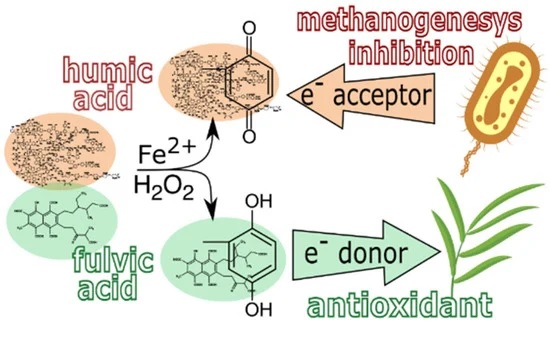Directed Synthesis of Humic and Fulvic Derivatives with Enhanced Antioxidant Properties
Volikov Alexander B., Mareev Nikita V., Konstantinov Andrey I., Molodykh Alexandra A., Melnikova Sofia V., Bazhanova Alina E., Gasanov Mikhail E., Nikolaev Evgeny N., Zherebker Alexander Ya, Volkov Dmitry S., Zykova Maria V., Perminova Irina V.
AGRONOMY-BASEL, 2021, , doi: 10.3390/agronomy11102047

Abstract
Redox moieties, which are present in the molecular backbone of humic substances (HS), govern their antioxidant properties. We hypothesized that a directed modification of the humic backbone via incorporation of redox moieties with known redox properties might provide an efficient tool for tuning up antioxidant properties of HS. In this work, hydroquinonoid and hydronaph- thoquinonoid centres were used, which possess very different redox characteristics. They were incorporated into the structure of coal (leonardite) humic acids CHA) and peat fulvic acids (PFA). For this goal, an oxidative copolymerization of phenols was used. The latter was induced via oxidation of hydroquinones and hydroxynapjtaquinones with a use of Fenton’s reagent. The structure of the obtained products was characterized using NMR and FTIR spectroscopy. H/D labelling coupled to FT ICR mass spectrometry analysis was applied for identification of the reaction products as a tool for surmising on reaction mechanism. It was shown that covalent -C-C- bond were formed between the incorporated redox centers and aromatic core of HS. The parent humic acids and their naphthoquinonoid derivatives have demonstrated high accepting capacity. At the same time, fulvic acids and their hydroquinonoid derivatives have possessed both high donor and high antioxidant capacities. The kinetic studies have demonstrated that both humic acids and their derivatives showed much slower kinetics of antioxidant reactions as compared to fulvic acids. The obtained results show, firstly, substantial difference in redox and antioxidant properties of the humic and fulvic acids, and, secondly, they can serve as an experimental evidence that directed chemical modification of humic substances can be used to tune and control antioxidant properties of natural HS.
